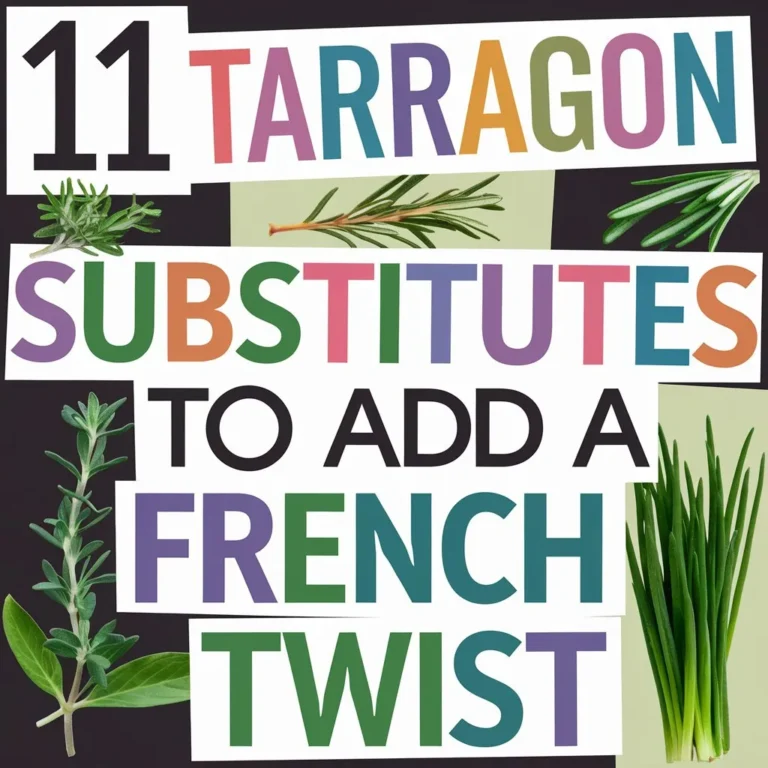11 Dill Substitutes to Add a Burst of Fresh Flavor
When you’re cooking up a storm and realize you’re out of dill, don’t panic! You’re about to discover a world of fresh flavor alternatives that’ll save the day.
From the familiar taste of parsley to the unexpected zing of lemon balm, these 11 dill substitutes will open your eyes to new possibilities.
You’ll find options that mimic dill’s bright, fresh flavor and others that add a surprising twist. Which one will you turn to when you need a flavor boost? The answer lies ahead, and it’s sure to take your dishes to the next level.
At a Glance

- Fresh parsley, basil, and lemon balm offer bright, fresh flavors as dill substitutes, perfect for Mediterranean-inspired dishes and summer recipes.
- Tarragon and fennel provide anise and licorice flavors, ideal for sauces, marinades, and salads, adding depth and complexity to dishes.
- Chives and cilantro bring onion and garlic undertones, making them suitable substitutes in many recipes, including Mexican and Indian dishes.
- Marjoram and thyme offer savory and earthy flavors, pairing well with fish, vegetables, and soups, and adding a unique twist to dill-based recipes.
- Caraway seeds provide a nutty zing, replicating dill’s anise-like taste and suitable for use in Middle Eastern, European, and Asian cooking.

Fresh Parsley to the Rescue
Most of your fresh herbs can be substituted, and fresh parsley is one of the best dill substitutes in a pinch.
You might be surprised by parsley’s versatility in replicating dill’s flavor profile. When you’re in a bind and can’t find fresh dill, parsley is an excellent alternative that will add a bright, fresh flavor to your dishes.
You can use parsley in a variety of fresh herb combinations to create unique flavor profiles.
For instance, pair parsley with chives and basil for a Mediterranean-inspired flavor or combine it with cilantro and dill (if you do have it on hand) for a fresh, herbaceous taste.
Parsley’s mild, slightly bitter flavor won’t overpower your dishes, making it an excellent addition to salads, soups, and sauces.
You can even use it as a garnish to add a pop of color and freshness to your finished dishes.
With its adaptability and mild flavor, parsley is a reliable substitute for dill that will elevate your cooking without overpowering it.
Tarragon’s Anise Flavor Profile
Tarragon’s unique flavor profile, marked by hints of anise and licorice, makes it an intriguing substitute for dill.
You might be surprised to find that tarragon’s anise flavor profile is reminiscent of sweet treats like licorice candies or anise-flavored cookies.
This French herb, commonly grown in herb gardens, adds a subtle yet distinct flavor to dishes.
When using tarragon as a substitute for dill, you’ll notice its slightly bitter and sweet undertones.
This complexity makes it an excellent addition to sauces, marinades, and salads.
Tarragon pairs particularly well with chicken, fish, and vegetables, adding a sophisticated twist to otherwise simple dishes.
In French cuisine, tarragon is often used to create classic dishes like Béarnaise sauce and chicken à la king.
You can also use it to add depth to soups, stews, and braises.
With its unique anise flavor profile, tarragon is an excellent choice for those looking to add a new dimension to their cooking.
Basil’s Sweet and Pungent Taste
As you explore alternatives to dill, you’ll find that basil’s sweet and pungent taste offers a distinct departure from the anise flavor profile of tarragon.
Basil’s aromatic essence is a perfect addition to summer basil recipes, where its bright, herbaceous flavor shines. In contrast to tarragon’s licorice undertones, basil brings a coolness that’s hard to resist.
Whether you’re making a classic caprese salad or a revitalizing summer soup, basil’s sweet and pungent taste adds depth and complexity.
When substituting basil for dill, keep in mind that basil has a more delicate flavor profile.
Start with a smaller amount and adjust to taste, as basil can quickly overpower other ingredients.
You’ll find that basil pairs beautifully with lemon, garlic, and olive oil, making it an excellent choice for Mediterranean-inspired dishes.
Its sweet and pungent taste also complements grilled meats, vegetables, and seafood, adding a burst of fresh flavor to any summer meal.
With its versatility and unique flavor profile, basil is an excellent addition to your culinary repertoire.
Chervil’s Delicate Onion Flavor
Fresh from the herb garden, chervil’s delicate onion flavor offers a subtle yet distinct alternative to dill’s bright, anise-like taste.
You’ll find that chervil’s versatility makes it an excellent addition to various dishes, from soups to salads and sauces. Its onion undertones are present but not overpowering, allowing you to add depth to your recipes without overwhelming the other flavors.
When using chervil as a dill substitute, you can expect a slightly sweeter and more delicate flavor profile.
This herb pairs well with ingredients like lemon, garlic, and mustard, making it an excellent choice for marinades, dressings, and sauces. Chervil’s subtle flavor also makes it an excellent addition to herbal teas, soups, and stews, where you want to add a hint of freshness without dominating the other flavors.
In general, you can use chervil in the same proportions as dill, but feel free to adjust to taste.
With its delicate onion flavor and versatility, chervil is an excellent dill substitute that will add a new dimension to your cooking.
Fennel’s Licorice Flavor Alternative
What if you want to replicate dill’s anise-like flavor without using dill itself?
Fennel is an excellent substitute, offering a similar licorice flavor profile that will add depth to your dishes. As an anise spice substitute, fennel’s sweet, mild flavor won’t overpower your recipes.
- Fennel’s crunchy texture and mild anise flavor make it an excellent addition to salads, sandwiches, and slaws.
- Its licorice flavor pairs well with fish, particularly salmon and trout, adding a fresh twist to seafood dishes.
- Fennel’s mild flavor won’t overpower delicate herbs like parsley or basil, making it an excellent addition to herb bundles.
- It’s a natural breath freshener, so you can use it as a palate cleanser between courses or as a post-meal digestive aid.
Caraway Seeds’ Nutty Zing
Three types of caraway seeds – black, brown, and white – offer a distinct nutty flavor that can effectively replicate dill’s anise-like taste.
You may be surprised to learn that caraway seeds have been used for centuries in various cuisines, including Middle Eastern, European, and Asian cooking.
In fact, caraway seeds have a rich history dating back to the ancient times, where they were used not only as a spice but also for medicinal purposes.
When substituting caraway seeds for dill, you’ll find that they’ve several benefits.
They’re a natural digestive aid, helping to alleviate bloating and indigestion.
Additionally, caraway seeds are rich in antioxidants, vitamins, and minerals, making them a nutritious addition to your meals.
To use caraway seeds as a dill substitute, simply grind them in a spice grinder or mortar and pestle to release their flavorful oils.
Start with a small amount, as caraway seeds can be quite potent, and adjust to taste.
With their unique nutty flavor and numerous benefits, caraway seeds are an excellent addition to your spice rack.
Dill-icious Chive Substitution
In addition to caraway seeds, another herb that can effectively mimic the flavor of dill is chives.
You might be surprised at how well chives can replicate the bright, fresh flavor of dill. The chive flavor profile is often described as mild onion with a hint of grassiness, which makes it an excellent substitute in many recipes.
When using chives as a dill substitute, keep in mind the following:
- Chives have a more delicate flavor than dill, so you may need to use a bit more to achieve the desired taste.
- Chive onion undertones can add depth to dishes like salads, soups, and sauces.
- Chives are especially well-suited for recipes where you want a subtle onion flavor without overpowering the other ingredients.
- Fresh chives are more pungent than dried, so use them sparingly to avoid overwhelming your dish.
Lemon Balm’s Bright Citrus
Explore the citrusy twist that lemon balm brings to the table as a dill substitute.
You’ll find that its citrusy herbal notes will add a bright, uplifting flavor to your dishes. When using lemon balm as a substitute, you can expect a more delicate taste compared to dill, but with a similar freshness.
To get the most out of lemon balm, try making a lemon balm infusion by steeping the leaves in hot water. This will help release the oils and flavors, making it perfect for sauces, marinades, or dressings.
In recipes, you can use lemon balm in place of dill in a 1:1 ratio.
However, keep in mind that lemon balm has a milder flavor, so you may need to adjust the amount used depending on your personal taste.
Pair lemon balm with ingredients like fish, chicken, or vegetables to create a light and revitalizing flavor profile.
With its unique citrusy twist, lemon balm is an excellent dill substitute that will add a new dimension to your cooking.
Marjoram’s Piney Freshness
Beyond the domain of citrusy flavors, marjoram’s piney freshness offers a unique twist as a dill substitute.
You might be surprised at how well marjoram pairs with ingredients you already use in dill-based recipes. Try it with fish, vegetables, or even in soups and stews.
Marjoram’s subtle bitterness and piney flavor profile create a fascinating contrast to dill’s bright, zesty taste.
Some of the benefits of choosing marjoram as a dill substitute include:
- Marjoram pairing options: It complements olive oil, garlic, and lemon beautifully, making it an excellent addition to Mediterranean-inspired dishes.
- Marjoram health benefits: Rich in antioxidants and anti-inflammatory properties, marjoram can help alleviate digestive issues and even reduce anxiety.
- Marjoram’s mild flavor won’t overpower other ingredients, allowing you to experiment with new flavor combinations.
- It’s a more affordable and accessible alternative to dill, especially if you’re cooking on a budget.
Thyme’s Savory Dill Substitute
Thyme’s pine-tinged aroma and savory flavor profile make it an unexpected yet intriguing dill substitute in many recipes.
You’ll find that thyme’s versatility allows it to seamlessly blend into a variety of dishes, from soups and stews to sauces and marinades.
As a bonus, thyme’s medicinal benefits, such as its antibacterial and anti-inflammatory properties, make it a great addition to your cooking.
When substituting thyme for dill, start with a small amount, as thyme’s flavor can be quite potent.
You can always add more, but it’s harder to remove the flavor once it’s added.
Thyme pairs particularly well with lemon, garlic, and olive oil, making it an excellent choice for Mediterranean-inspired dishes.
Its earthy undertones also complement vegetables like carrots and potatoes nicely.
Cilantro’s Pungent Coriander Flavor
While thyme’s savory flavor profile makes it a great dill substitute, cilantro brings a bold, pungent coriander flavor to the table, offering a distinct contrast to thyme’s earthy undertones.
You might find that cilantro’s strong, citrusy flavor adds a unique twist to your dishes, especially when used in combination with other herbs and spices.
- Enhance Mexican and Indian dishes: Cilantro is a staple herb in many traditional Mexican and Indian recipes, adding a bright, zesty flavor to salsas, salads, and curries.
- Add depth to soups and stews: Cilantro’s pungent flavor pairs well with rich, savory broths, making it an excellent addition to soups and stews.
- Brighten up salads and sandwiches: Cilantro’s citrusy notes can help balance rich or heavy ingredients in salads and sandwiches.
- Complement coriander spice blends: As a natural pairing, cilantro enhances the warm, earthy flavors found in coriander spice blends, commonly used in Middle Eastern and North African cuisine.
FAQs
Can I Use Dried Herbs as Substitutes for Fresh Dill?
When substituting fresh dill with dried herbs, you’ll find the shelf life of dried herbs is longer, but the flavor intensity is lower; adjust the spice ratio accordingly to achieve the desired taste, as dried herbs are typically 3 times stronger than fresh.
Do Dill Substitutes Have the Same Nutritional Value as Dill?
You’re wondering if dill substitutes match dill’s nutritional value; the answer is, it depends. While fresh herb benefits are undeniable, dill nutrition facts show it’s low in calories and rich in vitamins A and C.
Can I Combine Multiple Herbs to Replicate Dill’s Flavor?
You can craft a herbal fusion by combining multiple herbs to replicate dill’s flavor, but it requires careful flavor profiling; experiment with pairing sweet herbs like parsley or basil with tangy ones like tarragon or chervil to find your perfect blend.
Are Dill Substitutes Suitable for Pickling and Preserving?
When pickling, you’ll want to weigh your personal flavor profiles and preferences; some dill substitutes, like tarragon or parsley, can work well, but others might alter the taste, so bear in mind to experiment and find the right fit for you.
Can I Grow My Own Dill Substitutes at Home?
You can grow your own dill substitutes at home by mastering seed starting techniques and ensuring ideal soil conditions, such as well-draining soil with a pH between 5.5 and 6.5, to foster healthy growth and robust flavor.









DK Jacks is a passionate food enthusiast, recipe developer, and culinary explorer. With a love for both traditional and innovative flavors, DK brings a fresh perspective to the kitchen. When not experimenting with new ingredients, you’ll find DK capturing food moments through the lens or sharing cooking tips with fellow foodies.🍽️📸✨






